













These pages were scanned at 300 DPI and have been edited to improve clarity
etc., then reduced to 150 and 75 DPI. Additional editing was needed for some
pictures - see notes for individual illustrations. Many thanks to
 |
EXCITING EXPERIENCES IN THE JAPANESE-RUSSIAN WAR
Including The Cause of the War - The Relations of Nations to Each Other - A Short History of Japan and Russia. 843x703 / 966x1406 - Edited to remove stains etc. | ||
 | REPELLING ADMIRAL TOGO'S SECOND ATTEMPT TO SEAL UP PORT ARTHUR.
THE design of the Japanese for their second attempt to block the harbor was to sink four large merchant-steamers, which they sent in at 2 a.m., accompanied by six torpedo boats. Owing to the combined efforts of the sea and land forces, the steamers were driven out of their course, and sank at the side of the fairway. 354x550 / 708x1099 | ||
 | ENGLISH CREWS GOING ABOARD JAPANESE SHIPS AT GENOA, ITALY.
BEFORE the war the new Argentine cruisers Moreno and Rivadavia were bought by Japan. The scene represents the embarkation of a British crew on board the Nisshin, as one of them was renamed prior to its departure for Japan on the morning of January 9th, just a month before the engagement at Port Arthur. 352x564 / 704x1127 | ||
 | TORPEDO ATTACK ON PORT ARTHUR.
IN the above are illustrated: (i) the Japanese attack, indicated by arrows; (ii) the torpedo net under water being penetrated by torpedo cutter; (iii) the Brennan torpedo for harbour defense; (iv) the spar torpedo; (v) sections of the Whithead torpedo, used by the Japanese; (vi) explosive head of the Whithead; (vii) modern torpedo tube, in sections, used in Japanese Navy. 359x566 / 718x1131 | ||
 |
COMING OUT OF VLADIVOSTOK HARBOR.
THE first effect of the Japanese attack upon the Port Arthur fleet was an order from Viceroy Alexieff calling out the Russian fleet at Vladivostok. There was a prompt response, the huge battleships rushing out of the harbor to harass Japanese shipping, threaten her coasts, and divide the Japanese fleet, which was blocking the harbor of Port Arthur. 362x504 / 725x1008 | ||
 |
WARSHIPS ON THEIR LONG VOYAGE TO JAPAN. JAPAN purchased of the Argentine Republic two twin cruisers, christened the Kasuga and Nisshin. With British crews aboard, they started from Genoa, Italy, on the morning of January 9, 1904, arriving at Nagasakin in perfect order, a short time after the attack on Port Arthur. 348x550 / 697x1107 | ||
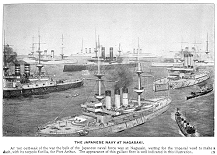 |
THE JAPANESE NAVY AT NAGASAKI.
AT the outbreak of the war the bulk of the Japanese naval force was at Nagasaki, waiting for the imperial word to make a dash, with its torpedo flotilla, for Port Arthur. The appearance of this gallant fleet is well indicated in this illustration. 396x354 / 793x708 | ||
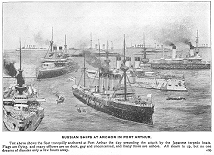 |
RUSSIAN SHIPS AT ANCHOR IN PORT ARTHUR.
THE above shows the fleet tranquilly anchored at Port Arthur the day preceding the attack by the Japanese torpedo boats. Flags are flying, and many officers are on deck, gay and unconcerned, and many more are ashore. All steam is up, but no one dreams of disaster only a few hours away. 497x360 / 993x720 | ||
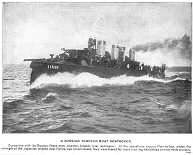 |
A RUSSIAN TORPEDO BOAT DESTROYER.
CONNECTED with the Russian fleets were nineteen torpedo boat destroyers. In the operations around Port Arthur, where the strength of the Japanese torpedo boat flotilla was concentrated, they were feared far more than big battleships or even swift cruisers. 497x399 / 992x797 | ||
 |
A SWIFT CRUISER OF THE RUSSIAN NAVY.
THE Russian Navy, of which the above is typical, did splendid execution in the naval contests of the war, and did fine service in the protection of Port Arthur at the commencement of the conflict. 503x386 / 1006x772 | ||
 |
THE GREAT RUSSIAN BATTLESHIP, THE CZAREVITCH.
THIS battleship, which was disabled by the first Japanese torpedo attack on Port Arthur, was built in 1901, and was the especial pride of the Russian Navy. It was commanded by Captain Grigorovitch, and was of 13,110 tons displacement. 445x320 / 890x641 | ||
 | ONE OF THE JAPANESE NAVAL HORNETS.
THE Usugunu was one of the twenty torpedo boat destroyers which, with the torpedo boats themselves, were rightly called the hornets of the Japanese Navy. They issued forth like lightning, and their sting was swift and sharp. 500x377 / 1000x744 | ||
 | A JAPANESE TORPEDO DESTROYER.
THIS is one of the little demons which played such a large part in the opening stages of the war. It is even more dangerous than it looks. 494x346 / 988x691 | ||
 | RUSSIAN SHIPS RETURNING TO PORT ARTHUR.
DURING several of the Japanese bombardments of Port Arthur by the blockading fleet, the swift cruisers of the Russian squadron advanced toward the enemy beyond the outer harbor, but not beyond the protection of the fortress guns. The warships of Japan would then disappear for a time, and those of Russia return to the harbor, covered in midwinter with a respectable layer of ice. 494x355 / 988x710 | ||
 | THE JAPS PUTTING ON THEIR WAR PAINT
IN A few hours from the recall of the Japanese minister from St. Petersburg, and the issuing of passports to the Russian minister at Tokyo, virtually the entire Japanese Navy was in war paint. The picture shows the painters at work. 500x389 / 1000x777 | ||
 | JAPANESE TORPEDO BOATS IN A ROUGH SEA.
ONE of the carefully-planned attacks of the Japanese torpedo flotilla upon the Russian fleet at Port Arthur was prevented by a terrible storm which swept the Yellow Sea. All but two were driven so far from their course as to fail to make the entrance for several days. 495x360 / 990x720 | ||
 | JAPANESE WASHIPS IN AN ADVANCE ON PORT ARTHUR.
NOTABLE features of the many advances made by the Japanese fleet on Port Arthur were both the dash of the movements and the accuracy of their lines of formation. Their maneuvres were executed with machine precision. These two traits constituted the naval strength which made it so formidable. 500x358 / 1000x716 | ||
 | TROOPS AND STORES FOR PORT ARTHUR.
ALTHOUGH the actual outbreak of war evidently found Russia unprepared, for many months she had been rushing troops and stores to Port Arthur. The picture above was taken at Port Said, and shows a Russian warship bound for Port Arthur coaling at the former point. 443x362 / 886x725 | ||
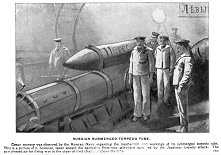 | RUSSIAN SUBMERGED TORPEDO TUBE.
GREAT secrecy was observed by the Russian Navy regarding the mechanism and workings of its submerged torpedo tube. This is a picture of it, however, taken aboard the battleship Pereiviet, afterwards damaged by the Japanese torpedo attack. The compressed air for firing was in the cigar-shaped chamber above the tube. 500x351 / 1000x703 | ||
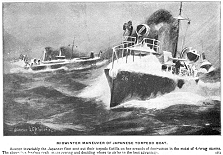 | MIDWINTER MANEUVER OF JAPANESE TORPEDO BOAT.
ALMOST invariably the Japanese fleet sent out their torpedo flotilla on her errands of destruction in the midst of driving storms. The above is a fearless craft maneuvering and deciding where to strike to the best advantage. 495x344 / 991x689 | ||
 | THE JAPANESE FIRST-CLASS BATTLESHIP YASHIMA.
ONE of the largest and most magnificent battleships connected with the Japanese Navy, being one of the six included in the first class. It was of 12.517 tons displacement, and was in the thick of many naval fights. 446x349 / 892x698 - Top of picture (above and betwen masts) edited to correct for paper curvature. | ||
 | SECTION OF THE RUSSIAN FLEET AT PORT ARTHUR.
THE above represents a portion of the Russian squadron blockaded by the Japanese fleet at Port Arthur, partly by the Japanese warships and partly by the four Japanese freighters sunk near the entrance to the harbor. 497x359 / 994x717 | ||
 | RUSSIAN GUNNERS WATCHING THE EFFECT OF A SIGHTING SHOT.
PRIOR to firing a 12-inch giant, it is customary to send a smaller shell at the target. This is called a sighting shot, and the Russian gun crew are eagerly watching the effect of this preliminary discharge. 494x365 / 988x730 | ||
 |
| ||
 | RUSSIAN TORPEDO BOAT FLOTILLA ESCORTED BY BATTLESHIP.
IT is always an anxious season for a military power when one of its torpedo boat flotillas is on the high seas, moving toward the scene of action. One of the last of the Russian torpedo boat destroyers to pass through the Red Sea was escorted by the battleship Osliabia, as seen above. 497x370 / 992x739 | ||
 | TYPES OF RUSSIAN AND JAPANESE SOLDIERS.
AT THE left are the Japanese artillery, cavalry, and infantry; at the right, the Russian Cossack, trooper, and artillerymen. In the center is one of the first-class Russian battleships, a giant of the line. 354x511 / 707x1022 | ||
 | WINTER TORPEDO PRACTICE ON BOARD A JAPANESE DESTROYER.
ALTHOUGH almost shop-worn with triteness, that old saying "Practice makes perfect," was the watchword of the Japanese in all their war preparations. The brilliancy shown by them in their torpedo attacks was the result of incessant and faithful practice, in all seasons and upon all available occasions. 497x356 / 995x713 | ||
 | INTERIOR OF A JAPANESE TORPEDO BOAT DESTROYER.
DURING the war much was heard about the torpedo boat destroyer, as well as the torpedo boat. A look at the interior shows that most of its space is devoted to boilers and engines. Here is seen a night attack on warships, with the crews madly at work in the rushing and tossing war-fiend. 509x345 / 1018x690 | ||
 | THE QUARTER-DECK OF THE JAPANESE BATTLESHIP ASAHI.
THE Asahi and Misaka, twin battleships, were the most powerful in the Japanese Navy. Each was of 15,443 tons displacement. The after barbette guns seen on the quarter deck were used at the bombardment of Port Arthur. 498x350 / 996x700 | ||
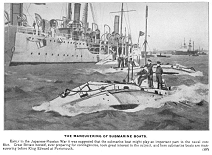 | THE MANEUVERING OF SUBMARINE BOATS.
EARLY in the Japanese-Russian War it was suggested that the submarine boat might play an important part in the naval conflict. Great Britain herself, ever preparing for contingencies, took great interest in the subject, and here submarine boats are maneuvering before King Edward at Portsmouth. 499x364 / 998x727 | ||
 | THE LAST JOURNEY OF THE ICE-BREAKER ON LAKE BAIKAL.
A SHORT time prior to the breaking out of the war the huge ice breaker, the Baikal, which has a carrying capacity of 3,000 men, made her last trip of the season. About the first of February, after prodigious and dangerous labors, the military railroad across the lake was announced to be in working order. 398x360 / 997x720 | ||
 | THE ILL-FATED RUSSIAN TRANSPORT, YENESEI, DEPOSITING MINES.
THIS transport, which was accidentally wrecked by one of its own mines, was provided, as seen, with a specially constructed stern port, for the depositing of Malinorowski mines. When the port was opened, a T-shaped spar was made to project over the water, and from this the mine was released. 492x381 / 985x762 - contrast adjusted to make mine illustration clearer | ||
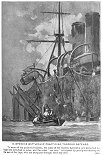 | A JAPANESE BATTLESHIP PRACTICING TORPEDO DEFENSE.
TO WARD off the projected torpedo, the sides of the modern battleship are protected by huge nets stretched on poles, and the order "out nets" is followed by prodigious activity on the part of the Japs, who are being put through their war drill. 352x533 / 703x1066 | ||
 | JAPANESE PRACTICING WITH A QUICK-FIRING GUN.
IN THEIR dashes to surprise the enemy, it was particularly desirable that the Japanese should be masters in the handling of quick-firing guns. They are seen here in one of their many practices aboard an ironclad. 357x532 / 714x1064 | ||
 |
| ||
 | THE DRY DOCK AT PORT ARTHUR. EARLY in the war the dry dock at Port Arthur was run to its full capacity in making repairs, especially upon the three disabled battleships torpedoed by the Japanese during their first attack. Many Finns were employed there as skilled workmen, the heaviest manual labour being put upon the coolies. 364x520 / 728x1039 | ||
 | RUSSIAN SAILORS PUTTING TORPEDOES ABOARD THE CZAREVITCH. EIGHT hours before the commencement of hostilirties between Japan and Russia the great Russian battleship, the Czarevitch, placed aboard a large number of torpedoes, in the expectation of launching them at the enemy. The torpedo attack of the Japanese flotilla, however, saved her that trouble, and she herself was made a battered target. 365x525 / 729x1050 |